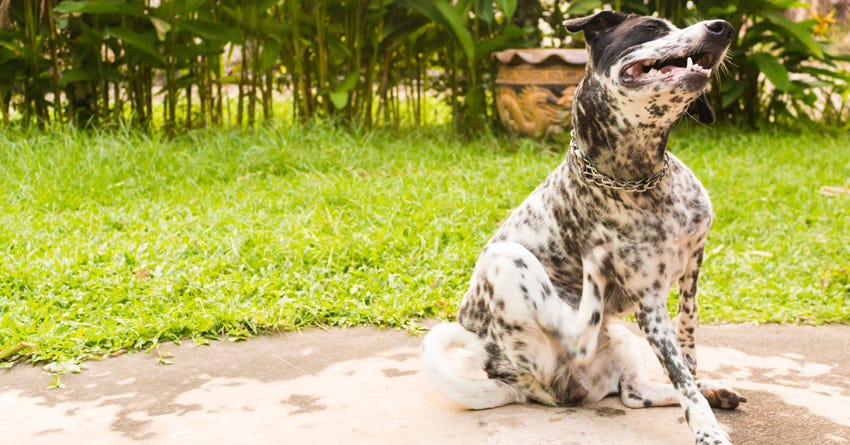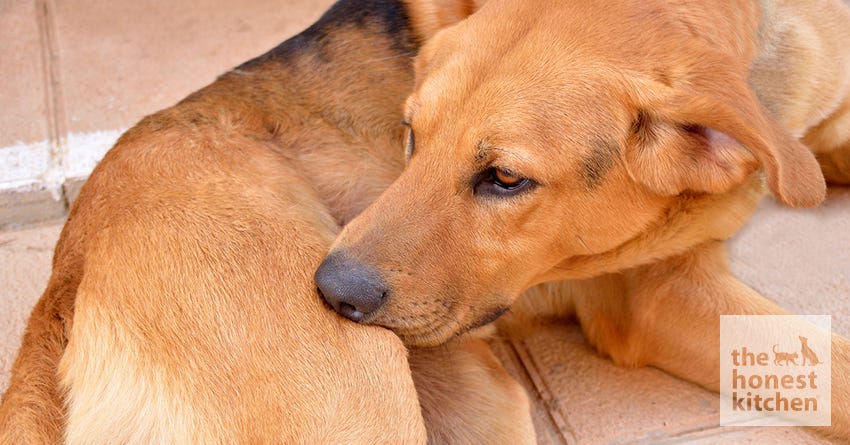Home Remedies For Preventing and Treating Hot Spots On Your Dog

You may be dealing with hot spots on dogs (or moist dermatitis) in your home and wondering what to do about it. You’ve come to the right place to learn more on the topic.
After reviewing the following information you’ll have the tools and knowledge you need to further prevent, treat at home, and know when to seek out veterinary help for hot spots on dogs. While there are ways to treat it yourself at home without a vet, your first order of business will be being able to identify what a hot spot is and notice that it’s there.
What are Hot Spots on Dogs?

A hot spot is often referred to by vets as moist dermatitis or damp heat. It’s a superficial common skin infection that happens when normal skin bacteria overrun the skin’s defenses as a result of damage to its surface. At the beginning stages of it, you may notice the skin becomes moist, red, itchy, and infected.
Common Causes of Dog Hot Spots
You may also be wondering what causes hot spots on dogs. More times than not, the hot spot will come about due to the dog chewing, licking, scratching, and gnawing at itself. The result of trauma to the area is inflammation and secondary bacterial infections. A few common causes of dog hot spots are as follows:
- Parasites
- Flea allergy or atopic dermatitis
- Food allergies
- Ear or skin infections
- Anal sac disease
- Contact irritants
- Stress or boredom which can result in excessive licking
- A coat that is dirty or matted
- Moisture trapped in the coat from swimming or bathing
Due to their thicker coats, some breeds such as Golden Retrievers, St. Bernards, German Shepherds, Labradors, and Rottweilers have a greater chance of developing hot spots.
Signs & Symptoms of Moist Dermatitis
The formation of moist dermatitis can be a very painful process for your pet. Pus will likely start to ooze from the traumatized skin as infection sets in. The dried pus and damaged skin surface will form a tightly adhered crust. You’re likely to notice hair loss over the infection site. Your dog will also probably show pain when the area is touched. While hot spots can occur anywhere, they’re most commonly seen on the head, limbs, and hips.
Preventative Ways to Keep Your Dog from Having Hot Spots

There are preventative ways to keep your dog from having hot spots so you can try to avoid this situation. Below are a few tips you may want to consider as you try to prevent them from occurring on your pet.
Parasite prevention
Good flea control is vital for keeping hot spots at bay and is the foundation for preventing itching.
Increase daily exercise and playtime
Keep boredom to a minimum by making sure your dog gets walks and has plenty of toys to play with.
Allergy and skin infection management
The most important part of a hot spot treatment is to prevent continued irritation of the area. Insect bites can often be safely treated at home, so long as you keep a careful eye on your pet to ensure that complications, such as an allergic reaction, do not occur. Groom your dog regularly and dry your dog after the coat becomes wet from bathing or swimming.
Monitor for foods that can cause hot spots
In Traditional Chinese Veterinary Medicine (TCVM), foods can be used for their energetic properties to help treat a medical condition. To use foods in this manner, one must understand the TCVM diagnosis and the specific properties of foods that can be used to correct the energetic imbalance. Hot spots are classically considered in TCVM diagnosis as “Damp Heat”. These are moist, red, and inflamed skin lesions that are warm to the touch.
Keep a healthy coat by introducing essential fatty acids into your pet’s diet.
In Traditional Chinese Veterinary Medicine (TCVM), foods can be used for their energetic properties to help treat a medical condition. To use foods in this manner, one must understand the TCVM diagnosis and the specific properties of foods that can be used to correct the energetic imbalance. Hot spots are classically considered in TCVM diagnosis as “Damp Heat”. These are moist, red, and inflamed skin lesions that are warm to the touch.
Keep a healthy coat by introducing essential fatty acids into your pet’s diet.
Foods and conditions that can lead to damp heat
- Dry kibble diet (these diets have a warming energetic due to processing at extremely high temperatures and are also dampening due to large carbohydrate load)
- Diet rich in carbohydrates
- TCVM “hot” or “warming” foods (venison, lamb, chicken, mutton)
- Dairy and fatty foods
- Obesity
To treat damp heat via TCVM food energetics, you can use an herbal formula and foods that have a cooling and damp draining effect.
Food with cooling properties
- Rabbit
- Turkey
- Duck
- Most fruits (especially apples, cranberries, pears, mango)
- Many vegetables (including, spinach, peas, kelp, broccoli, green beans)
Foods that are damp draining/resolving
- Alfalfa
- Barley
- Celery
- Green tea
- Parsnips
Home Treatment for Hot Spots & When to Call the Vet
Be glad to know there are a couple of home treatment options for hot spots. However, you should also know when to call the vet.
Trim around the infected area
You will need to trim the area around the lesion with animal clippers. This will allow the infection to breathe and for the medicine to do its work. If you don’t have animal clippers handy, you can use electric clippers. You may need a muzzle or a friend to hold your dog’s head while you work.
First, fill the wound with a water-soluble liquid. Cut the fur back around the wound until you have about a one-inch border. The height of the hair should be cut down to about half an inch.
After you’ve finished trimming, rinse the area thoroughly with warm water.
Cleanse the infected area
Clean the infected hot spot area with a non-irritating solution, such as an antiseptic liquid soap, antiseptic spray or a mild soap, and warm water. Pat dry and allow it to dry completely before applying medication.
You’ll also want to apply a warm compress three times daily to keep the area clean and encourage good circulation.
Apply a soothing treatment
After the hot spot wound is clean, you can apply a soothing treatment. Avoid using anything with stinging or astringent properties on an open wound. For a natural approach, try raw aloe or apply a cool chamomile tea bag to the infected area.
If you choose to use a cream or spray, make sure it’s pet-safe and veterinarian approved, like this hot spot spray for dogs by Great Life.
Protect the hot spot
To heal properly, hot spots need to breathe so you don’t want to wrap or bandage the area. You do, however, need to protect the area from your dog.
Yep, you got it…the cone of shame. You can purchase a recovery cone at your local pet store. Watch your dog closely and don’t allow your pet to lick, scratch, or itch the area while it’s healing.
Not all hot spot cases are solvable at home depending on what the primary cause was. If you were to take your dog to the vet then the vet would likely treat the hot spot using a combination of oral antibiotics, anti-itch medication, and an e-collar, depending upon the severity of it. Additional medications may be necessary to treat the underlying cause (i.e. flea prevention, allergy medication, and ear medication)
The Honest Kitchen Dog Foods with Cooling Property Proteins
You may want to consider The Honest Kitchen Foods with cooling properties as one form of prevention to avoid having to deal with hot spots on your dog. Below are a few of the foods to add to your list:
- Tender Turkey Stew For Dogs
- Limited Ingredient, Grain Free Duck Recipe For Dogs
- Turkey, Duck, and Root Vegetable Pate
Health Disclaimer: This post is educational in nature and doesn’t constitute health advice. Please consult your pet's veterinarian or other healthcare professionals for specific guidance on this topic.


